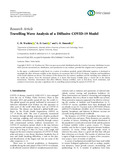| dc.contributor.author | C., M. Wachira | |
| dc.contributor.author | G., O. Lawi | |
| dc.contributor.author | L., O. Omondi | |
| dc.date.accessioned | 2022-11-04T13:01:51Z | |
| dc.date.available | 2022-11-04T13:01:51Z | |
| dc.date.issued | 2022-10-07 | |
| dc.identifier.uri | https://www.hindawi.com/journals/jam/2022/6052274/ | |
| dc.identifier.uri | https://doi.org/10.1155/2022/6052274 | |
| dc.identifier.uri | http://ir-library.mmust.ac.ke:8080/xmlui/handle/123456789/2111 | |
| dc.description.abstract | In this paper, a mathematical model based on a system of nonlinear parabolic partial differential equations is developed to investigate the effect of human mobility on the dynamics of coronavirus 2019 (COVID-19) disease. Positivity and boundedness of the model solutions are shown. The existence of the disease-free, the endemic equilibria, and the travelling wave solutions of the model are shown. From the numerical analysis, it is shown that human mobility plays a crucial role in the disease transmission. Therefore, interventions that affect diffusion (human mobility), such as lock-down, travel restrictions, and cessation of movement, may play a significant role in controlling and preventing the spread of COVID-19. | en_US |
| dc.language.iso | en | en_US |
| dc.publisher | HINDAWI: Journal of Applied Mathematics | en_US |
| dc.subject | Travelling, Wave, Analysis, Diffusive, COVID-19, Model | en_US |
| dc.title | Travelling Wave Analysis of a Diffusive COVID-19 Model | en_US |
| dc.type | Article | en_US |

